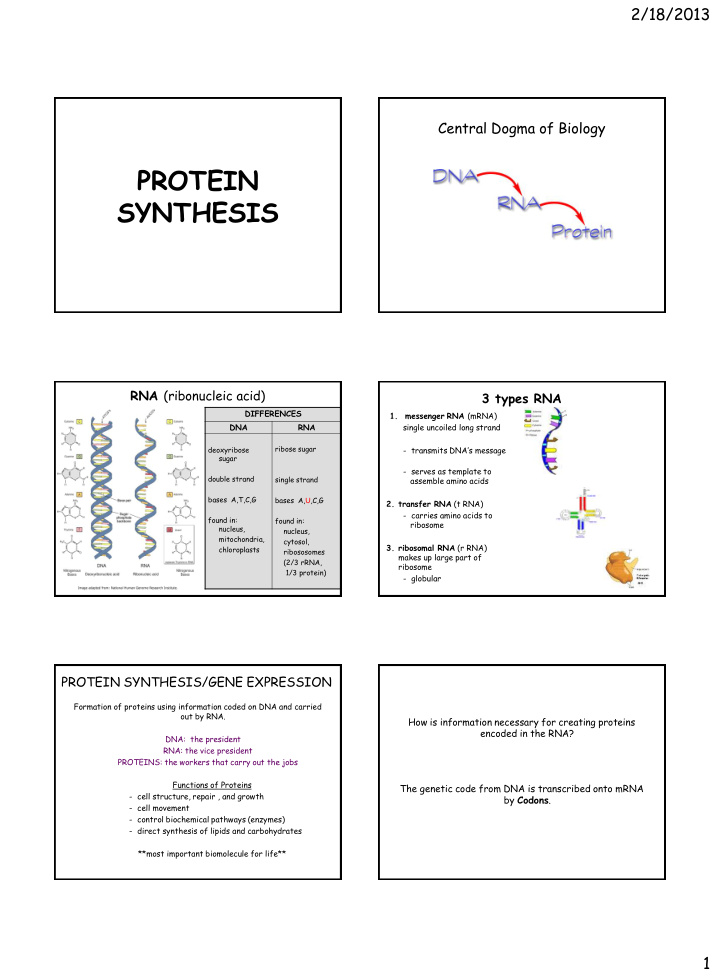



2/18/2013 Central Dogma of Biology PROTEIN SYNTHESIS RNA (ribonucleic acid) 3 types RNA DIFFERENCES 1. messenger RNA (mRNA) DNA RNA single uncoiled long strand ribose sugar deoxyribose - transmits DNA’s message sugar - serves as template to double strand single strand assemble amino acids bases A,T,C,G bases A,U,C,G 2. transfer RNA (t RNA) - carries amino acids to found in: found in: ribosome nucleus, nucleus, mitochondria, cytosol, 3. ribosomal RNA (r RNA) chloroplasts ribososomes makes up large part of (2/3 rRNA, ribosome 1/3 protein) - globular PROTEIN SYNTHESIS/GENE EXPRESSION Formation of proteins using information coded on DNA and carried out by RNA. How is information necessary for creating proteins encoded in the RNA? DNA: the president RNA: the vice president PROTEINS: the workers that carry out the jobs Functions of Proteins The genetic code from DNA is transcribed onto mRNA - cell structure, repair , and growth by Codons . - cell movement - control biochemical pathways (enzymes) - direct synthesis of lipids and carbohydrates **most important biomolecule for life** 1
2/18/2013 Code Word/Codon (triplet): specific group of 3 successive bases on DNA and mRNA How many combinations of code words/codons can we make from 4 bases? - codes for a specific amino acid to be placed on the protein chain - 20 biological amino acids, but more than 20 codons 64 combinations ( 4 3 = 64) Like “genetic words” DNA code words: ACA, GCA, TTA RNA codons: TGU, CGU, AAU ** each code word always codes for same amino acid** How do these code words affect protein synthesis? Order of code words codes for Order of amino acids codes for Specific type of protein Ala: Alanine Cys: Cysteine Asp: Aspartic acid Glu: Glutamic acid Phe: Phenylalanine Gly: Glycine His: Histidine Ile: Isoleucine Lys: Lysine Leu: Leucine Met: Methionine Asn: Asparagine Pro: Proline Gln: Glutamine Arg: Arginine Ser: Serine Thr: Threonine Val: Valine Trp: Tryptophane Tyr: Tyrosisne Stages of Protein Synthesis Stages of Protein Synthesis I. Transcription (nucleus) • Building of proteins - first main stage - mRNA made from DNA 2 Stages Steps of transcription 1. Transcription 1. The part of the DNA to be (makes mRNA) transcribed unzips (only one strand of DNA molecule needed for 2. Translation transcription) (makes protein) start codon: AUG always codes for methionine 2
2/18/2013 Transcription, cont. 2. Complementary nucleotides 3. A. Messenger RNA is made until are added to the end of RNA a stop codon is reached. II. Translation (in cytoplasm at ribosome) - second main stage - stop codons: (once RNA nucleotides are UAA, UAG, UGA attached to DNA chain, - process whereby protein is synthesized (created) codons are in proper order) B. Newly formed m RNA goes from mRNA into cytoplasm to ribosomes - occurs in cytoplasm C. DNA rewinds - gene has 100x more nucleotides than the protein it makes Ex: 100 a.a. = 300 nucleotides transcription animation 2 Components of Translation Steps of translation (second main stage) 1. Transfer RNA (t RNA) 2. Ribosome - function: transfers amino 1. Subunits attach with MRNA in between them acids to ribosome - 2 subunits make up ribosome (ribosome ready for protein synthesis) - 20 types – one for each - normally apart in cytoplasm, amino acid (specific for come together during each a.a.) protein synthesis - Ribosome moves down mRNA and reads its message - found in cytosol - amino acid 1 will always be methionine 3.stop codon is reached (UAA, UGA, or UAG). 2. A. T-RNA with its amino acids bond to ribosomes A. subunits separate (can be used over again) B. first a.a. joins to second a.a. B. protein is released into cell C. ribosome moves down mRNA and first tRNA is released to be used over again C. mRNA is broken down by cell (not be used again) D. amino acids continue to be added to protein chain thru D. tRNA is released into cell same mechanism (used over again) Protein synthesis animation Protein synthesis animation 2 3
Recommend
More recommend